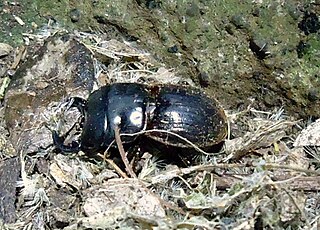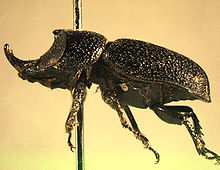
The family Scarabaeidae, as currently defined, consists of over 35,000 species of beetles worldwide; they are often called scarabs or scarab beetles. The classification of this family has undergone significant change in recent years. Several subfamilies have been elevated to family rank, and some reduced to lower ranks. The subfamilies listed in this article are in accordance with those in Catalog of Life (2023).

Stag beetles are a family of about 1,200 species of beetles in the family Lucanidae, currently classified in four subfamilies. Some species grow to over 12 centimetres, but most to about 5 cm (2 in).
The false stag beetles (Diphyllostoma) are a group of three species of rare beetles known only from California. Almost nothing is known of their life history beyond that the adults are diurnal and females are flightless; larvae have not been observed.

The term mycangium is used in biology for special structures on the body of an animal that are adapted for the transport of symbiotic fungi. This is seen in many xylophagous insects, which apparently derive much of their nutrition from the digestion of various fungi that are growing amidst the wood fibers. In some cases, as in ambrosia beetles, the fungi are the sole food, and the excavations in the wood are simply to make a suitable microenvironment for the fungus to grow. In other cases, wood tissue is the main food, and fungi weaken the defense response from the host plant.

Lucanus cervus, known as the European stag beetle, or the greater stag beetle, is one of the best-known species of stag beetle in Western Europe, and is the eponymous example of the genus. L. cervus is listed as Near Threatened by the IUCN Red List.

Actaeon beetle is a rhinoceros beetle of the family Scarabaeidae.

Odontolabis cuvera, the golden stag beetle, is a beetle of the family Lucanidae, stag beetles.

Chiasognathus grantii is a species of stag beetle found in Argentina and Chile. It is known as Darwin's beetle, Grant's stag beetle, or the Chilean stag beetle.

Cyclommatus is a genus of the family Lucanidae, also known as the stag beetle. The majority of the species from the genus Cyclommatus are located in Southeast Asia, though some species are found in China and Taiwan as well. The genus Cyclommatus also consists of three subgenera: Cyclommatus, Cyclommatinus and Cyclommatellus. Each subgenera contains 80, 24 and 3 species respectively. In total, the genus Cyclommatus consists of a total of 134 species, though more are still being discovered to this day.

Hexarthrius parryi, the fighting giant stag beetle, is a species of large stag beetles. It belongs to the genus Hexarthrius of the tribe Lucanini. It is classified under the subfamily Lucaninae of the stag beetle family Lucanidae.

Lamprima aurata, the golden stag beetle, is a species of beetle in the family Lucanidae. In Tasmania, this species is referred to by the "common name" of Christmas beetle, a name that is normally used for beetles in the family Scarabaeidae, genus Anoplognathus.
Syndesus ambericus is an extinct species of stag beetles in the subfamily Syndesinae known from a single possibly Miocene fossil found on Hispaniola. S. ambericus is the first species of stag beetle to have been described from fossils found in Dominican amber and is one of four species from amber, and the only stag beetle species known from the Caribbean.

Geodorcus helmsi,New Zealand giant stag beetle or Helms's stag beetle is a large, slow-moving, flightless stag beetle in the family Lucanidae. It is endemic to New Zealand.

Geodorcus capito is a large flightless species of stag beetle in the family Lucanidae. It is endemic to the Chatham Islands in New Zealand.

Geodorcus alsobius, or Moehau stag beetle, is a large flightless species of stag beetle in the family Lucanidae. It is found only on Mt Moehau, the highest mountain in the Moehau Range on the Coromandel Peninsula in New Zealand.

The rhinoceros stag beetle, also known as the horned stag beetle, or simply the rhinoceros beetle, is a species of stag beetle native to Europe. It is characterised by a clear sexual dimorphism.
Hexarthrius melchioritis is a species of beetle, which belongs to the family of stag beetles (Lucanidae) in the group Scarabaeoidea.
Chiasognathus sombrus is a beetle which belongs to the family of stag beetles (Lucanidae) in the group Scarabaeoidea.

Heliocopris bucephalus, commonly known as the Elephant dung beetle, is a species of dung beetle found in India, Sri Lanka, Bangladesh, Myanmar, Malay Peninsula, Java, Vietnam, Laos, and Cambodia.














